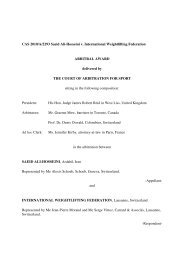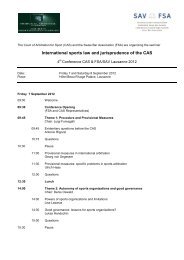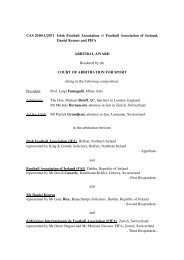(CAS) Bulletin - Tribunal Arbitral du Sport / TAS
(CAS) Bulletin - Tribunal Arbitral du Sport / TAS
(CAS) Bulletin - Tribunal Arbitral du Sport / TAS
Create successful ePaper yourself
Turn your PDF publications into a flip-book with our unique Google optimized e-Paper software.
in 2011.<br />
The Athlete has approached each of the six<br />
manufacturers that pro<strong>du</strong>ced the pro<strong>du</strong>cts made<br />
available to the Astana riders in 2010 and received<br />
confi rmation that:<br />
a) none of them use or store clenbuterol or any other<br />
substance from WADA’s Prohibited List in their<br />
warehouses;<br />
b) none of them have ever been blamed for an<br />
athlete’s positive anti-doping test; and<br />
c) all of them carry out external, independent<br />
testing of their pro<strong>du</strong>cts, none of which have ever<br />
revealed the presence of clenbuterol.<br />
The Panel notes that the Appellants do not contest<br />
the three foregoing points.<br />
According to Mr Contador, those declarations by the<br />
supplement manufacturers, in themselves, render it<br />
virtually impossible that clenbuterol could have been<br />
a contaminant in any of the supplements the Athlete<br />
was taking.<br />
For Mr Contador, the Appellants therefore argue<br />
in a last desperate bid that he may have been taking<br />
a supplement that he deliberately did not disclose<br />
because he “knew that he would not escape a sanction as the<br />
use of food supplements is never considered as a fully exonerating<br />
explanation”.<br />
Mr Contador submits that the Appellants suggestion<br />
here assumes that the Athlete would have known<br />
which one of the supplements he was taking was<br />
contaminated with clenbuterol and thus deliberately<br />
chose not to disclose information about that<br />
particular supplement when he provided the RFEC<br />
the names of the 27 different supplements that were<br />
made available by the Astana team to its riders.<br />
According to Mr Contador, not only is the Appellants’<br />
submission in this regard a preposterous speculation,<br />
it is also yet more evidence of the repulsive approach<br />
taken by the Appellants to the Athlete’s case. The<br />
Panel need only consider how the unsubstantiated<br />
proposition made by the Appellants here would be<br />
received if it were made by an athlete who claimed his<br />
positive test had been caused by a supplement.<br />
Findings of the Panel<br />
The Panel considers – based on the evidence before it<br />
– that the supplement theory is possible. This is true<br />
even if one assumes that Mr Contador only took one<br />
of the supplements contained in the list.<br />
Quality checks of pro<strong>du</strong>cts and/or regular doping<br />
tests on the athletes of the First Respondent’s team<br />
may render an adverse analytical fi nding based on<br />
contaminated supplements less likely, but do not<br />
exclude it. In the same manner as the random controls<br />
performed on livestock farming in Spain and Europe<br />
cannot guarantee that contaminated meat will not<br />
reach the consumer, the above-described precautions<br />
cannot exclude that a contaminated batch of<br />
supplements reaches an athlete.<br />
In respect to whether or not the First Respondent<br />
may have used supplements not mentioned on the list,<br />
the Panel is of the opinion that the assertions of the<br />
Athlete himself and the statements of his teammates<br />
are insuffi cient in terms of evidence to rule out that<br />
possibility.<br />
Having found that it is possible that the adverse<br />
analytical fi nding was caused by the ingestion of<br />
contaminated food supplements, it remains to be<br />
examined whether the meat contamination theory<br />
or the food supplement theory is more likely to have<br />
occurred.<br />
7. Is the Meat Contamination Theory more likely<br />
to have occurred than the Supplement Theory?<br />
As has been shown above, the Panel has to assess<br />
the likelihood of different scenarios that – when<br />
looked at indivi<strong>du</strong>ally – are all somewhat remote for<br />
different reasons.<br />
However, since it is uncontested that the Athlete did<br />
test positive for clenbuterol, and having in mind that<br />
both the meat contamination theory and the blood<br />
transfusion theory are equally unlikely, the Panel<br />
is called upon to determine whether it considers<br />
it more likely, in light of the evidence ad<strong>du</strong>ced,<br />
that the clenbuterol entered the Athlete’s system<br />
through ingesting a contaminated food supplement.<br />
Furthermore, for the reasons already indicated, if<br />
the Panel is unable to assess which of the possible<br />
alternatives of ingestion is more likely, the Athlete<br />
will bear the burden of proof according to the<br />
applicable rules.<br />
Considering that the Athlete took supplements in<br />
considerable amounts, that it is incontestable that<br />
supplements may be contaminated, that athletes<br />
have frequently tested positive in the past because of<br />
contaminated food supplements, that in the past an<br />
athlete has also tested positive for a food supplement<br />
contaminated with clenbuterol, and that the Panel<br />
considers it very unlikely that the piece of meat<br />
Jurisprudence majeure / Leading cases<br />
-<br />
139





